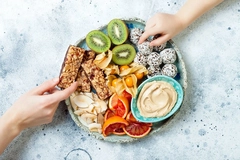Fazer begins xylitol production from oat hulls after US$315 million production investment
03 May 2022 --- Fazer is upcycling oat hulls generated at its mills to create xylitol, a sugar replacer with 40% fewer calories (2,4 kcal/g) starting its commercial production.
In the last three years, the Finnish company has invested €300 million (US$315 million) in oats derivatives.
The scientific team of Fazer identified that oat hulls contain a high amount of xylose, the raw ingredient to create xylitol. And now, the company is exploring selling its xylose extraction technique to companies with a large oat mill.
“Realizing the opportunity to create a more sustainable xylitol. Fazer decided to invest for the future of people and the planet with a zero-waste policy and a low carbon footprint supported by a circular economy resulting in the most sustainable xylitol in the world,” James Dedman, VP at Fazer Lifestyle Foods, tells FoodIngredientsFirst.

“Our new xylitol factory in Finland is a brilliant example of a circular economy, preventing waste, and in which side streams are upcycled intelligently. After processing the xylitol, what remains of the oat hulls is used as bioenergy,” adds Christoph Vitzthum, president and CEO of Fazer Group.
Xylitol is also an essential ingredient for Fazer’s confectionery business, which is the only company producing chewing gum in Finland.
 Fazer’s xylitol factory in Lahti, Finland, started operations in April (Credit: Fazer).High interest in the sweet patent
Fazer’s xylitol factory in Lahti, Finland, started operations in April (Credit: Fazer).High interest in the sweet patent
There is a “significant amount of interest” in Fazer’s patent for the production of xylitol from oats, as the method is “easily transferable to large oat mills,” says Dedman. About 90% of the company’s xylitol innovation will be exported, with a particular interest in Europe, the US and Asia.
Europe and Asia accounted for 59% of all new product launches in the sugar and sweeteners category between 2020 and 2021, according to data from Innova Market Insights.
Also, the fact that the oat hulls are upcycled taps into Innova Market Insights’ Top Ten Trend 2022, “Upcycling Redefined”. This trend highlights how adopting strategies to use by-products or ingredients that would otherwise be discarded as waste through upcycling creates an opportunity that benefits from reducing food waste.
Food and beverage launches with a food waste/upcycling claim are expanding with an average annual growth of +69% (Global, CAGR 2017-2021).
Xylitol is used in food applications such as chewing gum, mints, jams and marmalades.
“All polyols provide a laxative effect if consumed in quantities that exceed the recommended limit, and all polyols have different levels of toleration in the human diet. As with all polyols, using more than 10% in a formulation will require wording on the label that states that the product may produce laxative effects,” explains Dedman.
Fazer is not the only company extracting polyols, as Roquette, a plant protein and pharmaceutical excipients expert, launched its US$28.8 million liquid and powder polyols plant in March in France. Eyeing the sugar reduction in its products as its main target.
Pharmaceutical and cosmetic applications of xylitol
As a sugar replacement, the ingredient has diverse applications. It is an efficient neutral carrier for all kinds of pharmaceutical products: cough syrups, tablets, children’s vitamins and more. According to Fazer, daily use of xylitol can reduce the plaque buildup that might cause cavities (Credit: Fazer).
According to Fazer, daily use of xylitol can reduce the plaque buildup that might cause cavities (Credit: Fazer).
According to Fazer, daily use of xylitol can reduce the plaque buildup that might cause cavities. Also, “gum sweetened with 100% xylitol has been shown to reduce dental plaque,” says Dedman. It is also used in oral care products such as toothpaste or hydration spray.
Medically, foods containing xylitol instead of sugar induce a lower blood glucose rise after their consumption compared to sugar-containing foods. This makes them safe for diabetics; otherwise, such as with all products, the overall glycaemic effect needs to be taken into account.
Xylitol has a health claim approved by the European Food Safety Authority.
In cosmetic formulations, xylitol protects the skin microbiome, with the ingredient having a moisturizing effect on the skin, according to Fazer. The mechanism relates to increased tight junction and barrier formation in the skin.
Sugar losing market space
Concerns over sugar intake have put pressure on the sugar and sweeteners category, with the new products released in the sugar and sweeteners sector being only 0.42% of all products released (down from 0.62 five years early), according to 2021 data from Innova Market Insights.
At the same time, there is an increasing interest in natural sugars, such as fruits and better-for-you options with reduced sugar.
In April, Barry Callebaut unveiled a US$104 million specialty chocolate plant to produce free-from foods, such as sugar-free or dairy-free. The largest capital investment ever in a factory in North America.
By Marc Cervera











